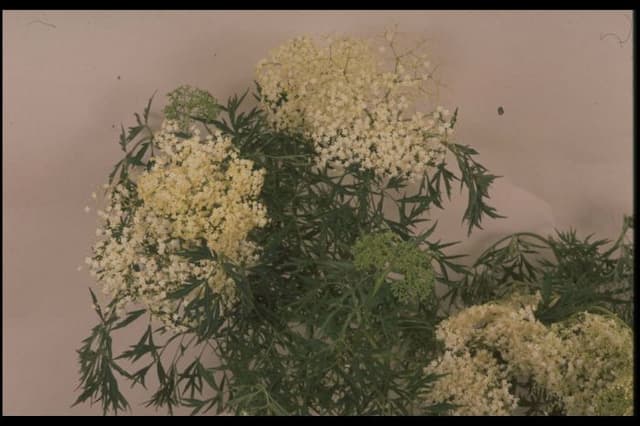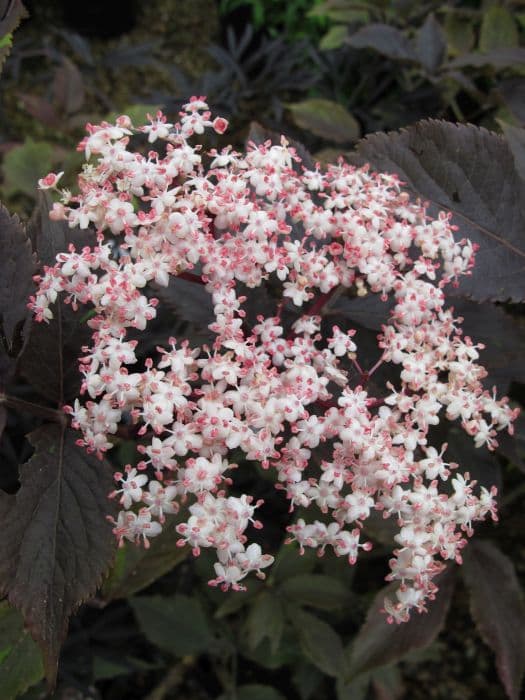Guelder Rose Viburnum opulus 'Aureum'

ABOUT
Viburnum opulus 'Aureum', commonly known as the guelder rose, is a striking shrub with a rounded, bushy habit. It features three-lobed, maple-like leaves which emerge with a golden-yellow color in spring. As the seasons progress, the foliage transitions to a softer yellow-green hue, before turning attractive shades of red and purple in the fall, creating a year-round interest. The guelder rose is adorned with large, lacecap-style flowers in late spring to early summer. These blooms are characterized by a ring of sterile, showy outer flowers encircling a center of smaller fertile flowers, which are usually a creamy white color. Following the bloom period, the shrub produces clusters of translucent red berries that persist into winter, offering a striking contrast against the foliage and providing a food source for birds. The bark of the guelder rose is textured and adds to the overall ornamental quality of the shrub. The branches can create a dense and layered look, which can be a visual highlight in any garden or landscaped area. Overall, the guelder rose is a versatile and decorative plant that provides color and interest throughout different seasons, with its glowing leaves, elegant flowers, and eye-catching berries.
About this plant
 Names
NamesSynonyms
Guelder Rose, European Cranberrybush, Water Elder, Cramp Bark, Snowball Tree, Golden Guelder Rose
Common names
Viburnum opulus var. aureum, Viburnum opulus f. aureum
 Toxicity
ToxicityTo humans
The common name for Viburnum opulus 'Aureum' is Guelder Rose. The Guelder Rose is considered to have some level of toxicity to humans. The berries in particular contain compounds that can lead to mild to moderate symptoms if consumed in large quantities. These symptoms may include stomach upset, nausea, vomiting, and diarrhea. In terms of possible consequences, although it is rare, consumption of a large amount of the berries might lead to more severe symptoms and medical attention should be sought if significant quantities are ingested or if poisoning is suspected.
To pets
The Guelder Rose can also be toxic to pets if parts of the plant, especially the berries, are ingested. Similar to humans, pets that consume Guelder Rose berries may experience gastrointestinal distress, which can include vomiting, diarrhea, and abdominal pain. In more severe cases, if a pet consumes a large number of berries, it might lead to more serious symptoms that would require veterinary attention. Pet owners should monitor their animals to prevent ingestion and seek professional advice if they suspect their pet has eaten any part of the plant.
 Characteristics
CharacteristicsLife cycle
Perennials
Foliage type
Deciduous
Color of leaves
Gold
Flower color
White
Height
8 feet (2.4 meters)
Spread
8 feet (2.4 meters)
Plant type
Shrub
Hardiness zones
3
Native area
Europe
Benefits
 General Benefits
General Benefits- Landscape Aesthetics: Offers bright, decorative foliage and clustered white flowers for visual interest in gardens.
- Wildlife Attraction: Provides nectar for pollinators like bees and butterflies, and berries for birds.
- Seasonal Interest: Features year-round interest with spring blooms, vibrant summer foliage, fall color changes, and winter berries.
- Privacy Screen: Dense growth can be used to create natural privacy barriers in landscapes.
- Erosion Control: Can be used on slopes to help stabilize soil and prevent erosion.
- Low Maintenance: Typically requires minimal care once established in a suitable location.
- Hedge or Border Planting: Ideal for use in hedges or as a border due to its shape and size.
 Medical Properties
Medical Properties- Antispasmodic: Used traditionally to relieve muscle spasms, particularly in cases like menstrual cramps or muscle tension.
- Sedative: Sometimes employed for its mild sedative effects to alleviate nervous tension and anxiety.
- Diuretic: May be used to promote the excretion of urine, which could support the treatment of urinary tract conditions.
- Astringent: Can be applied topically to tighten the skin and mucous membranes, which might help in reducing inflammation and healing wounds.
 Air-purifying Qualities
Air-purifying QualitiesThis plant is not specifically known for air purifying qualities.
 Other Uses
Other Uses- The stems of the Guelder rose can be used to make small handcrafted items such as walking sticks or tool handles due to their strength and flexibility.
- It's possible to use the branches of the Guelder rose in basket weaving, as their natural curve and pliability are suitable for creating sturdy, attractive baskets.
- The Guelder rose wood is sometimes used for marquetry, a craft where pieces of wood in various shapes, sizes, and species are applied to a structure to form decorative patterns.
- In woodworking, small blocks of Guelder rose wood can be used for fine inlays or detailed carvings, due to its texture and grain.
- Guelder rose's ornamental berries are used in floral arrangements to provide a splash of color, particularly in autumn and winter displays.
- Gardeners might plant Guelder rose as a hedge plant for its dense growth habit, which can provide privacy and noise reduction.
- Guelder rose can provide a habitat and food source for various species of birds, which eat the berries and seek shelter in the foliage.
- The fall foliage of the Guelder rose with its bright red leaves can be used as a natural dye in fabric and wool dyeing processes.
- Insect hotels made using hollow branches or twigs from the Guelder rose can offer a nesting and hibernation place for beneficial insects like bees and ladybugs.
- Cultural or ceremonial uses in certain traditions may include using branches or flowers from the Guelder rose plant for decorative purposes during festivals or events.
Interesting Facts
 Feng Shui
Feng ShuiThe Guelder Rose is not used in Feng Shui practice.
 Zodiac Sign Compitability
Zodiac Sign CompitabilityThe Guelder Rose is not used in astrology practice.
 Plant Symbolism
Plant Symbolism- Protection: The dense, intertwined branches of the Guelder Rose create a protective shield, symbolizing safety and refuge.
- Unity: The rounded shape of the Guelder Rose's blooms represents coming together and the solidarity of a group or family.
- Boundaries: Historically, Guelder Rose was planted as a hedge, symbolizing the setting of clear personal boundaries.
- Perseverance: Guelder Rose is known for its hardiness, symbolizing the ability to endure challenges and persist through hard times.
- Well-being: In some cultures, Guelder Rose berries were used for medicinal purposes, making the plant a symbol of health and healing.
 Water
WaterFor the European Cranberry Bush, which is the common name of Viburnum opulus 'Aureum', it is essential to maintain consistent moisture. In general, water deeply once a week, providing about 1 to 1.5 gallons of water for each shrub. During hot, dry periods, you may need to water twice a week, especially for plants in full sun. Avoid shallow watering, as it promotes weak root development. In the winter, reduce watering since the plant will enter dormancy and require less moisture.
 Light
LightThe European Cranberry Bush thrives in full sun to partial shade. The ideal location would provide morning sunlight and afternoon shade, particularly in hotter climates, to prevent leaf scorch. However, this adaptable plant can also do well in a spot that receives dappled sunlight throughout the day if intense direct sun is not available.
 Temperature
TemperatureThe European Cranberry Bush is hardy and can withstand a temperature range from about -30 to 30 degrees Fahrenheit. Its ideal growing temperatures are between 60 and 75 degrees Fahrenheit. This shrub is quite frost-tolerant and can survive in cold winters, making it suitable for many temperate regions.
 Pruning
PruningPruning the European Cranberry Bush is essential for maintaining shape and encouraging healthy growth. Prune immediately after flowering since the plant blooms on old wood. Remove any dead or diseased branches, and thin out old stems to promote new growth. It is generally recommended to prune every year, lightly shaping the shrub to maintain its appearance and vitality.
 Cleaning
CleaningAs needed
 Soil
SoilGuelder rose prefers fertile, well-drained soil with a pH of 5.5 to 6.5. A mix of loam, compost, and sand can provide good structure and nutrients. Mulching helps retain moisture and improve soil quality.
 Repotting
RepottingGuelder rose, when grown in a container, should be repotted every 3-5 years, ideally in the spring before new growth begins. Choose a slightly larger pot to allow for growth.
 Humidity & Misting
Humidity & MistingGuelder rose thrives best in average humidity conditions, typical of outdoor environments, without the need for additional humidity adjustments.
 Suitable locations
Suitable locationsIndoor
Place the Guelder rose in bright, indirect light indoors, and ensure good air circulation.
Outdoor
Plant Guelder rose in partial shade with well-drained soil outdoors.
Hardiness zone
4-8 USDA.
 Life cycle
Life cycleThe European Cranberry Bush 'Aureum' begins its life cycle with seed germination, which occurs in favorable conditions of moisture and temperature, usually in the spring. After sprouting, it enters into a vegetative growth phase where roots, stems, and leaves develop as it matures into a young plant. In subsequent years, it undergoes further growth and begins to form flower buds; flowering generally takes place in late spring or early summer, with the plant displaying characteristic creamy-white blossoms. After pollination, typically by insects, the flowers develop into red berries by late summer or fall, which are an important food source for birds. As the plant matures, it can reach up to 2-4 meters in height and develops a rounded habit. It enters a period of dormancy during the winter months, with leaves turning red or purplish before dropping, and the plant rests until the next growth cycle begins in the spring.
 Propogation
PropogationPropogation time
Spring-Early Summer
Propogation: The most popular method for propagating the European Cranberrybush 'Aureum', scientifically known as Viburnum opulus 'Aureum', is softwood cuttings. This technique is usually done in the late spring or early summer when the plant's new growth is still tender and pliable. Cuttings should be about 4 to 6 inches long, with a couple of sets of leaves remaining at the top. The lower leaves are removed and the cutting is dipped in rooting hormone before being planted in a moistened mix of half peat and half perlite or sand to encourage root growth. The cuttings should then be placed in a warm area with indirect sunlight and covered with a plastic bag to maintain humidity. It may take several weeks for the cutting to root; once rooted, it can be transplanted into soil.









